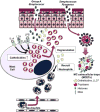Skin microbiome and mast cells
- PMID: 28390799
- PMCID: PMC5538027
- DOI: 10.1016/j.trsl.2017.03.003
Skin microbiome and mast cells
Abstract
Microbiotas in the skin have high levels of diversity at the species level, but low phylum-level diversity. The human skin microbiota is composed predominantly of Gram-positive bacteria especially Actinobacteria, which are the dominant bacterial phylum on the skin. Lipoteichoic acid (LTA) is a major constituent of the cell wall of Gram-positive bacteria and is therefore abundant in the skin microbiome. Recent studies have shown that LTA, and other bacterial products, permeates the whole skin and comes into contact with epidermal and dermal cells, including mast cells (MCs), with the potential of stimulating MC toll-like receptors (TLRs). MCs express a variety of pattern recognition receptors, including TLRs, on their cell surface in order to detect bacteria. Recent publications suggest that the skin microbiome has influence on MC migration, localization and maturation in the skin. Germ free (no microbiome) animals possess an underdeveloped immune system and immature MCs. Despite much research done on skin microbiota and many papers describing skin interaction with "the good microbiota", there is still controversy regarding how mast cells, communicate with surface bacteria. The present review intends to quell the controversy by illuminating the communication mechanism between bacteria and MCs.
Copyright © 2017 Elsevier Inc. All rights reserved.
Figures



References
-
- Vliagoftis H, Befus AD. Rapidly changing perspectives about mast cells at mucosal surfaces. Immunol Rev. 2005;206:190–203. - PubMed
-
- Forsythe P. Microbes taming mast cells: Implications for allergic inflammation and beyond. Eur J Pharmacol. 2016;778:169–75. - PubMed
-
- Gurish MF, Austen KF. Developmental origin and functional specialization of mast cell subsets. Immunity. 2012;37:25–33. - PubMed
Publication types
MeSH terms
Grants and funding
LinkOut - more resources
Full Text Sources
Other Literature Sources
Medical

